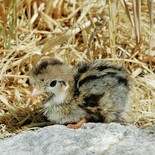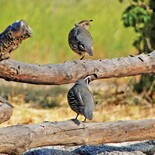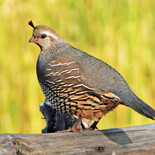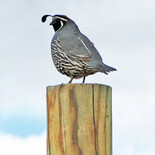Nesting California Quail and the marvel of 'Physiological zero'
Land of Four Seasons
July 8, 2023
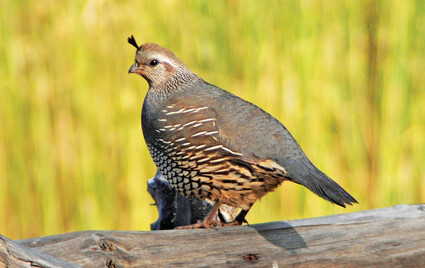
Jon Hammond.
A female California Quail lacks the male's black face, white facial markings and curving topknot, but she is nonetheless a finely-marked and beautiful bird.
I've enjoyed seeing a couple of pairs of California Quail (Callipepla californica) that were hanging around the houses and outbuildings of our old farm last month, calling to each other with the classic quail phrase that's heard so often throughout the Tehachapi Mountains: "Come-back-here!" or "Ca-KERR-cow!"
These quail pairs leisurely make their way up the dirt driveway and adjacent grassy areas in the middle of the morning, unhurriedly pecking at seeds and small insects. Songbirds, by contrast, are consumed with building nests or actively caring for their new young. You might wonder "What's up with the lazy quail? Why aren't they being parents like the other birds?" Well, the answer involves a phenomenon called "physiological zero."
California Quail are ground-nesting birds whose simple nest consists of a shallow depression a couple of inches deep, usually about 6 to 10 inches across and lined with grasses. In this concealed nest, the female typically lays 10-14 eggs – cream colored and lightly speckled or blotched. Larger clutches have been found with up to 28 eggs, but these extreme clutches are likely the result of "egg-dumping," when one female lays her egg in another female's nest while the occupant is away.
There are no bird species whose females lay more than one egg a day, and sometimes they skip a day, so it takes awhile for a quail hen to fill up her nest. During this process, she will lay an egg early each morning, and then slip away with her mate to forage through the spring landscape – that's what was occurring at our place.
The reason the female quail hasn't started incubating yet is due to one of the most interesting and fundamental facts about bird eggs: after being laid, the embryo inside an egg pauses development unless it's kept at a temperature of 68 degrees Fahrenheit or warmer. The ideal incubation temperature is typically 98 to 100 degrees Fahrenheit. The eggs will remain in a sort of suspended animation, undeveloped but still viable, until they are exposed to the sustained elevated temperatures of incubation.
This useful quality is referred to as the physiological zero factor of egg development. In humans, the term physiological zero refers to the temperature that your skin will perceive as neither warm nor cold, and is about 80 degrees Fahrenheit. Bird eggs that are cooler than their physiological zero temperature will remain undeveloped.
This is crucial for birds that lay large clutches, for it allows them to lay one egg a day for up to several weeks, then start incubating them all. After the required incubation period (23 days for California Quail, 21 days for chickens), the entire clutch hatches within a few hours of each other, even though the earlier eggs are many days older than the last eggs that were laid.
This "hatching synchrony," as its called, allows quail parents to produce a clutch of babies that are all about the same size and at the same developmental stage in life, instead of ending up with a staggered hatching and young that ranged in age from two weeks old to newly hatched. It is difficult to imagine how quail and other birds could manage to successfully raise large broods without the vital physiological zero factor allowing eggs of different ages to hatch simultaneously.
Some bird species with small clutches, including raptors such as eagles, begin incubating as soon as the first egg is laid. This results in a graduated hatching, with the first chick emerging at least a couple of days earlier than the youngest. This headstart is very significant and usually insurmountable, and the younger chicks tend not to survive.
That's okay for an enormous bird with a long lifespan and no predators, like an eagle, but for a small game bird like California Quail that must face many hungry enemies, they need to successfully produce large clutches and have most of their babies survive, not just the oldest one or two chicks.
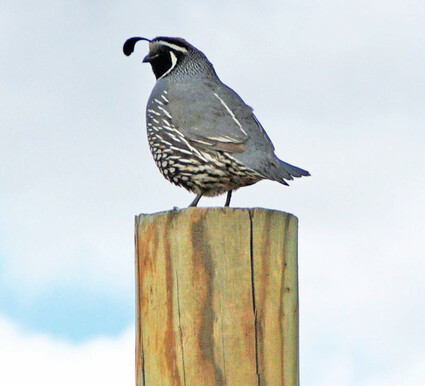
Jon Hammond.
A male California Quail performing sentry duty on a post at dusk. Silhouettes of these graceful, rounded little gamebirds bracket the days, at the breaking dawn and the fading twilight.
So the quail parents around Tehachapi are either still producing eggs or incubating them, and the first broods of adorable little striped babies will appear any day now. They'll be able to follow their parents short distances within hours of hatching. Observing the pleasant, age-old lifecycle of California Quail each year is just one of the many, many great things about living in this area.
Keep enjoying the beauty of life in the Tehachapi Mountains.
Jon Hammond is a fourth generation Kern County resident who has photographed and written about the Tehachapi Mountains for 38 years. He lives on a farm his family started in 1921, and is a speaker of Nuwä, the Tehachapi Indian language. He can be reached at tehachapimtnlover@gmail.com.


